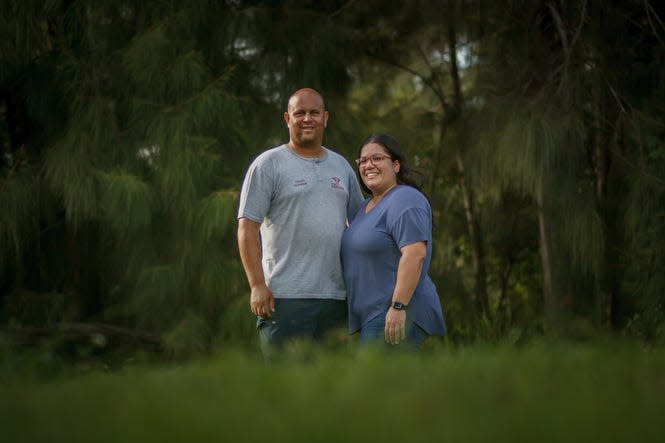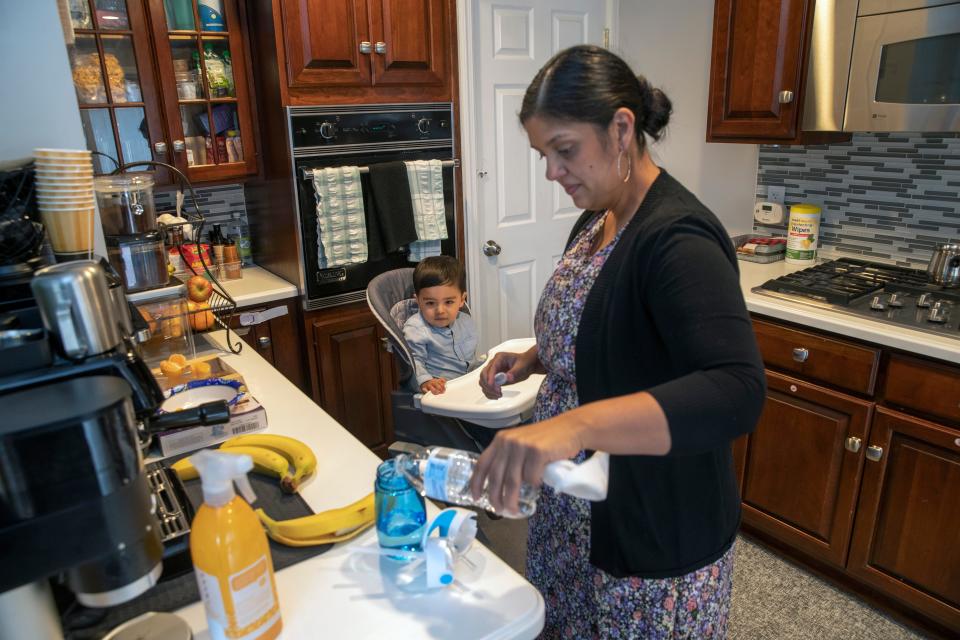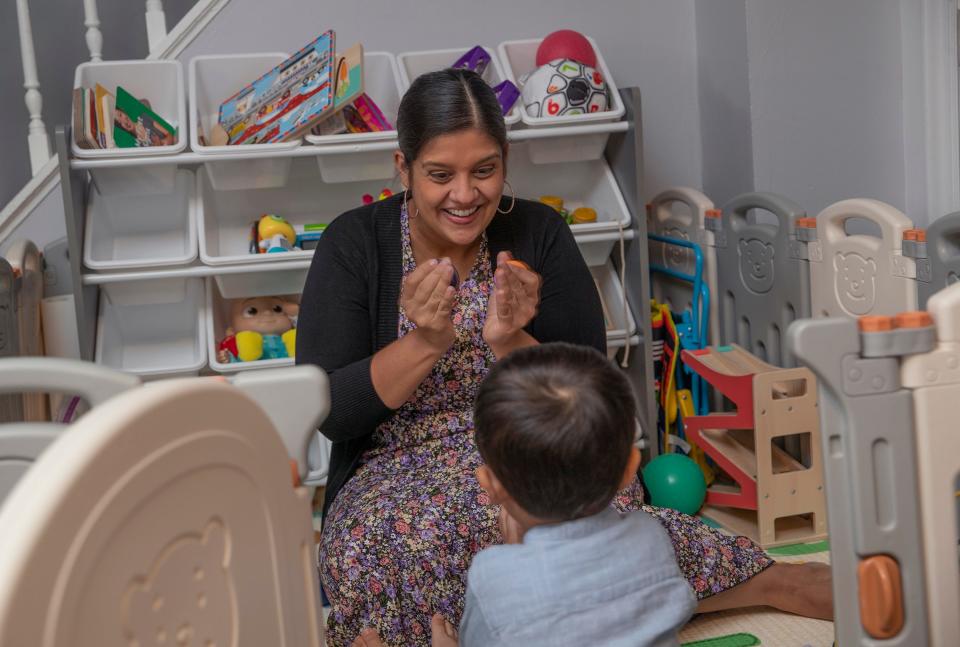Recession, hurricanes, service cuts: Why Puerto Ricans are leaving the island for the mainland
When Angie Cruz's family home in Puerto Rico was devastated by Hurricane Maria in September 2017, Cruz packed up her elderly grandmother, toddler son and young niece to stay with an aunt in Chicago.
It was supposed to be temporary.
But weeks turned into months, and months have turned into nearly two years. Her grandmother longs to return to the island, and Cruz misses it too. Still, they are making a home in Chicago, among thousands of other American citizens who are part of the Puerto Rican diaspora.
For more than a century, the 3,500-square-mile island in the Caribbean has been a U.S. territory whose people are American citizens. Citizenship made it easier for Puerto Ricans to leave the island for New York, Chicago and other cities on the mainland.
The exodus to the mainland, though, has accelerated recently amid a 15-year depression and hurricanes and earthquakes that destroyed homes and left millions without power – in some cases for nearly a year. New decennial census data released in August show Puerto Rico lost nearly 440,000 people, representing about 12% of its population, over the past decade.
Today, more Puerto Ricans live in the 50 states than on the island.
Advocates say policy decisions have only made the situation worse. A fiscal control board established by Congress a decade after the island's recession began accelerated the squeeze on public services and further damaged quality of life on the island, they say.
“The natural disasters only exacerbated what was already there, which were man-made disasters," said Erica Gonzalez, director of Power 4 Puerto Rico, a national network of Puerto Rican diaspora organizations.
Population losses have compounded the crises the island faces. The exodus means fewer wage earners, less money in taxes and fewer paths out of the island's economic collapse.
“The older population I think are more attached to the island. The younger population probably they see, maybe over there I can find something else, another job,” Cruz said. “I came here with the mentality I’m coming here for a couple months and then I’m going to go back. I ended up staying because I found a job. I ended up going to school. I was like, 'No I need to think about my kids first more than what I’m used to.'”
An historical trend
If Puerto Rico were a state, as some want, its 3.3 million people would make it the 30th largest in the country but one of only four that lost population from 2010 to 2020.
Carlos Vargas-Ramos, a researcher at Hunter College's Center for Puerto Rican Studies in New York, says migration in and out of the island generally runs alongside economic trends. When Puerto Rico's economy underperforms, more people leave. When conditions in the states deteriorate, they return.
Then came 2006. Puerto Rico was an early harbinger for the Great Recession that would devastate the global economy. That was the same year Congress ended special tax breaks that had buoyed the island's economy.
Without the tax breaks, jobs began to disappear, said Federico de Jesús, senior policy adviser at Power 4 Puerto Rico.
Employment on the island peaked over the past two decades at about 1.3 million jobs in December 2006, according to the Bureau of Labor Statistics. The island had about 987,000 jobs in September, according to the latest data available.
The economic damage compounded in the decadeplus to follow. The loss of tax revenue when corporations left the island pushed governments to borrow money, creating a debt crisis that ultimately crippled the island's public finances, de Jesús said.
Then in 2016 Congress created a fiscal control board to deal with the territory's $70 billion in debt. Gonzalez said "crippling austerity cuts" stemming from the board's decisions have hurt well-being on the island.
Some of the oversight board's work slowed during the COVID-19 pandemic. But it has touted milestones such as balancing Puerto Rico's budget.
Natural disasters made Puerto Rico only more inhospitable, Vargas-Ramos said. Hurricane Maria killed nearly 3,000 people on the island in September 2017, and problems with access to electricity have persisted in the years since. Earthquakes have rocked the island as it tried to rebuild after Maria.
“You had conditions that made it very difficult for people to survive," he said.
Finding opportunity
For the Rivera Colón family in south Florida, leaving Puerto Rico was all about opportunity.

Jennifer Colón, 39, her husband, Ismael Rivera, 42, and their three children moved from Toa Alta, a city of 67,000 southwest of San Juan, in 2017, just after Hurricane Maria devastated the island.
Before their move, Colón was working in a call center and Rivera was a clerk at a food distribution company. They worked full-time, but it was still nearly impossible to make ends meet. Puerto Rico had a minimum wage of $7.25 an hour until Gov. Pedro Pierluisi raised it to $8.50 in September.
"I didn't have enough to keep my kids comfortable," Colón said. "I knew after the hurricane that prices on the island would go up, for light, for water and for food. That was going to be so difficult for us."
The family now lives in an apartment in West Palm Beach, Florida, where Colón works as an administrative assistant and Rivera works in apartment maintenance. In her free time, Colón makes and sells pastries, cakes, jewelry, hair bows and pasteles de Navidad, a Puerto Rican take on tamales that are typically wrapped in banana leaves instead of corn.
They joke that living stateside is like being on vacation but that living in Florida isn't like going to Walt Disney World every day. Colón and Rivera have worked to create a community of friends willing to help one another out.
But the transition wasn't easy.
“None of us knew English, even basic English,” Colón said. “I had three kids that needed to learn English and needed help, but I couldn’t help them.”
The couple now run a family Facebook page with 164 members in the mainland United States, where they share updates from around the country. The group includes family members who left the island in 1950, up until the family's most recent transplants, who moved stateside in 2017.

Growing communities
The Colón Rivera family isn't alone in South Florida. In Palm Beach County, 24% of the population is Hispanic. Puerto Rican advocacy groups estimate that about 16% of that population is made up of Puerto Rican people.
Florida has been a magnet in the Puerto Rican exodus. The 45,000 Puerto Ricans who migrated to Florida in 2018 were about four times more than the next-closest state, according to the U.S. Census Bureau.
Experts told USA TODAY that established Puerto Rican communities in places like Florida and New York attract new migrants, who then disperse around the country.
“A lot of Puerto Ricans have someone in the mainland. That makes it easier for them to leave," said Gustavo Velez, an economist and former Puerto Rican government official. "The ones who are in the mainland are saying: 'OK, I have a better life, my quality of life has improved. Come here and I’ll help you.'"
Puerto Rican populations increased in Pennsylvania, Texas, Illinois and several other states as well in 2018, according to the Census Bureau's American Community Survey.
About 5.2 million Puerto Ricans lived stateside in 2015, the latest data available show. About 3.5 million were U.S. citizens born in the states, compared with 1.5 million born in Puerto Rico or in U.S. island areas.
The island has suffered from "brain drain," Velez said, as graduates from the University of Puerto Rico leave for higher pay, lower taxes and better lives in the states. That means the island's remaining population is growing older. In 2010, about 20% of Puerto Rico's population was over 60, compared with nearly 28% in 2019, the latest data available show.
The promise of higher pay lured Natalia Giraldo-Santiago to Glendale, Arizona, when she was 25 with a freshly minted master's degree in social work. The $36,000 salary she was offered after a job fair was as much as her parents, a teacher and a secretary, earned combined on the island.
Giraldo-Santiago, now 32, has since moved to Houston to pursue a doctorate at the University of Houston in a state with a growing Puerto Rican population. That combination of opportunity and community, she said, have anchored her in the states.
“Now I’m at a point where I know this is where I want to stay," she said.
Education and opportunity
As younger people like Giraldo-Santiago have left the island for new opportunities, its education system has spiraled.
The University of Puerto Rico has lost tens of millions of dollars in funding after the fiscal control board called for slashing its appropriation by more than half by 2022.
The island's K-12 public education system also has endured school closures over the last 15 years. In 2006, the island had more than 1,500 operational public schools. Today, it has 849, according to the National Center for Education Statistics.
As schools closed, enrollment on the island cratered. In the fall of 2000, more than 600,000 children were enrolled in Puerto Rico's public elementary and secondary schools. By 2018, the latest data available from the center, that was cut in half to just more than 300,000.

Education and opportunity have always been important to Joan Perez’s family. It’s why today, she’s a bilingual teacher at an elementary school in New Brunswick, New Jersey, equipped with two master’s degrees from Rutgers University.
But it’s more than 1,500 miles from her hometown of Bayamón, Puerto Rico.
Perez moved to New Jersey to pursue a master’s degree in 2014. She originally planned to return to Puerto Rico, but with a well-paying job offer secured in New Jersey before she even graduated, the decision to stay was an easy one.
With her salary, Perez lives a comfortable life in Bayonne, New Jersey with her husband and two young sons. It’s a far cry from how she would live in Puerto Rico, where her mother, who has been a teacher for almost 40 years, makes a third of what Perez makes.
“New Jersey offers you so much in the way of living and opportunities that are not the same in Puerto Rico,” Perez said. “You can have a nicer house, make more money and live in a nicer area. You can have a good job so your kids can have a better life.”

Colón, Rivera and their children spoke with The Palm Beach Post in Spanish.
This article originally appeared on USA TODAY: Puerto Rico is losing population to the mainland U.S.: Census data

